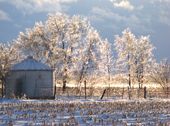In the past, anytime I'd ever seen Fire Pinks - which hasn't been often - I wanted to get out my pocket trowel, scoop some up and take them home with me. However, the first time I saw them was at a friend's parents' home in Hot Springs, Arkansas. A few grew in their woods and they were beloved plants to them. I just couldn't ask for some.
But when I found some in a friend's woods nearby, and they had given us permission to take whatever wildflowers we would like, it was just too much to resist. Being a respecter of nature and not wanting to destroy a glorious natural habitat such as theirs, I limited myself to a few small plants last spring, brought them home to a partially shady spot in my garden, and hoped for the best.
The best is what I got.
This spring - now, in fact - we are reveling in the red blooms of our Fire Pinks (Silene virginica var. virginica) right in our very own garden. The blooms have more than tripled in number since last year - proof that we are being good stewards of our native flora. The blooms won't last forever, so of course I had to capture them with my camera.
Fire Pinks (Silene virginica var. virginica)
I've read that they like rocky, acidic soil. That's not where we found these and that's not where they're planted now. We have alkaline soil here in northwest Ohio and it tends to be a little more on the mucky clay side. ("Tends to be" is being polite about it!)
I've also read that they're a short-lived perennial, only living two to three years. That makes me wonder if they'll return for me next year. I think I'll let these go to seed, just in case.
Why am I so entranced by these wildflowers? Maybe it's because they're red and that's my favorite color. Perhaps it's because they're not often seen in our area. (They may be here, just not in obvious locations.) In any case, I'm not the only one who loves these scarlet beauties. The Ruby-throated Hummingbird is its principal pollinator. We've got some of those, too.
Trivia: Wonder how they got their name? Pinks, as a group of flowers, are called this because of the zig-zag edges to their petals, as if they were trimmed with pinking shears. In fact, the color pink got its name from the flower (coined in 1573), not the other way around! And of course, you know where the "fire" part comes from.




















 "Bejeweled"
"Bejeweled"



9 comments:
We brought some into our garden as well. They are perennial for us. They are in our garden but under tough wildflower conditions.
It is always good to know that wildflowers can be somewhat adaptable - if we are lucky. Beautiful photos of a beautiful flower.
That's beautiful Kylee. How neat about the name and the shape of the leaves. They do look like they were cut with shears. Glad you were able to find some for your gardens.
mothernaturesgarden ~ I'm hoping these will thrive in our garden! They certainly aren't pampered. The soil here is likely much like where we found them, just seven miles away, though probably not as rich. Time will tell!
CommonWeeder ~ Thanks, Pat! I always feel lucky when wildflowers flourish in my garden here!
Becca's Dirt ~ I liked finding that out about their name, too! (And the name of the color pink!)
One of my favorite wildflowers! At a former home, pinks grew all over the bright areas of the woods near the creek.
Cameron ~ I'll bet that was stunning! Nothing quite like red to grab your attention!
How exciting to have such a huge clump after such a short time. They are beauties. I can see why you love them so.
We have some at Gene Stratton-Porter State Historic Site, but they are hiding behind a tree so visitors can't easily see them. Every year from 1913 to 1919 Gene planted foxfire; she also mentioned them in her books. It took me quite a while to determine that was the common name almost a century ago for Fire Pinks.
What a wonderful post. I love how it got the name "pinks"!
Post a Comment